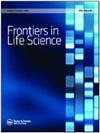甜味剂对红茶和绿茶中酚类化合物自由基清除活性的影响机制
Q1 Biochemistry, Genetics and Molecular Biology
引用次数: 29
摘要
摘要本研究旨在评价两种茶(绿茶和黑茶)在添加或不添加甜味剂(蔗糖或阿斯巴甜)时抗氧化活性与酚类化合物含量的关系。对水提物的总多酚和总黄酮含量进行了筛选。采用2,2 -二苯基-1-吡啶肼基(DPPH)自由基法和2,2 ' -氮基-双[乙基苯并噻唑-6-磺酸](ABTS)法测定提取物的抗氧化活性,并以丁基羟基苯甲醚为标准化合物。此外,我们用高效液相色谱法(HPLC)鉴定了多酚类化合物。结果表明,其抗ABTS自由基活性高于DPPH自由基。茶样水提物的抗氧化活性与酚类化合物含量呈正相关。结果还表明,添加蔗糖显著降低了绿茶的抗氧化活性(蔗糖为4.0%时,抗氧化活性从95.8%下降到90.6%)。然而,红茶中同样的蔗糖增加了抗氧化活性(从87.0%增加到91.9%,蔗糖为4.0%)。HPLC分析表明,不含蔗糖和添加1.0%蔗糖的绿茶和红茶中咖啡因含量最高(分别为6081.8、8772.1、6474和3755µg/100g)。肉桂酸在相同茶叶样品中的含量最低,分别为0.21、0.25、0.19和0.18µg/100g。邻苯三酚、儿茶酚、表儿茶素、鞣花素、原儿茶素在绿茶中的含量明显高于红茶。本文章由计算机程序翻译,如有差异,请以英文原文为准。
Suggested mechanism for the effect of sweeteners on radical scavenging activity of phenolic compounds in black and green tea
ABSTRACT The present work aims to evaluate the relation between the antioxidant activities and phenolic compound contents of two tea samples (green and black) mixed with or without sweeteners (sucrose or aspartame). The aqueous extracts were screened for total polyphenol and flavonoids contents. Antioxidant activities of extracts were tested using 2, 2-diphenyl-1-picrylhydrazyl (DPPH) radical method and 2, 2′-azino-bis [ethylbenzthiazoline-6-sulfonic acid] (ABTS) methods using butylated hydroxyl anisole as standard compound. In addition, we identified polyphenols compounds using high performance liquid chromatography (HPLC). The results indicated that the antioxidant activity was higher against ABTS radical more than DPPH radical. Also, there is positive correlation between the antioxidant activity and phenolic compounds content presented in water extracts of tea samples. The results also indicated that addition of table sugar to green tea significantly decreased the antioxidant activity (from 95.8% to 90.6% with 4.0% sucrose). However, the same table sugar in black tea increased the antioxidant activity (from 87.0% to 91.9% with 4.0% sucrose). The analysis using HPLC showed that caffeine was the most predominant individual compounds in green and black tea without and with 1.0% sucrose (6081.8, 8772.1, 6474 and 3755 µg/100g, respectively). However, cinnamic acid showed the lowest content in the same tea samples (0.21, 0.25, 0.19 and 0.18 µg/100g respectively). Pyrogallol, catechol, epicatechin, ellagic, protocatchuic were significantly higher in green tea than in black tea.
求助全文
通过发布文献求助,成功后即可免费获取论文全文。
去求助
来源期刊

Frontiers in Life Science
MULTIDISCIPLINARY SCIENCES-
CiteScore
5.50
自引率
0.00%
发文量
0
期刊介绍:
Frontiers in Life Science publishes high quality and innovative research at the frontier of biology with an emphasis on interdisciplinary research. We particularly encourage manuscripts that lie at the interface of the life sciences and either the more quantitative sciences (including chemistry, physics, mathematics, and informatics) or the social sciences (philosophy, anthropology, sociology and epistemology). We believe that these various disciplines can all contribute to biological research and provide original insights to the most recurrent questions.
 求助内容:
求助内容: 应助结果提醒方式:
应助结果提醒方式:


